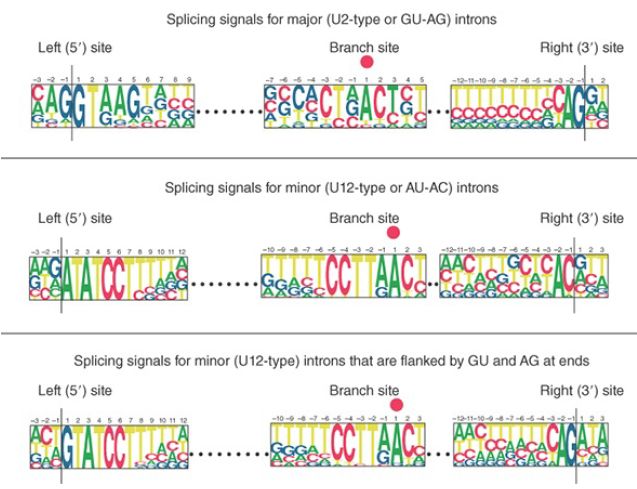


 النبات
النبات
 الحيوان
الحيوان
 الأحياء المجهرية
الأحياء المجهرية
 علم الأمراض
علم الأمراض
 التقانة الإحيائية
التقانة الإحيائية
 التقنية الحيوية المكروبية
التقنية الحيوية المكروبية
 التقنية الحياتية النانوية
التقنية الحياتية النانوية
 علم الأجنة
علم الأجنة
 الأحياء الجزيئي
الأحياء الجزيئي
 علم وظائف الأعضاء
علم وظائف الأعضاء
 الغدد
الغدد
 المضادات الحيوية
المضادات الحيوية|
Read More
Date: 7-12-2015
Date: 15-3-2021
Date: 17-5-2016
|
Nuclear Splice Sites Are Short Sequences
KEY CONCEPTS
- Splice sites are the sequences immediately surrounding the exon–intron boundaries. They are named for their positions relative to the intron.
- The 5′ splice site at the 5′ (“left”) end of the intron includes the consensus sequence GU.
- The 3′ splice site at the 3′ (“right”) end of the intron includes the consensus sequence AG.
- The GU-AG rule (originally called the GT-AG rule in terms of DNA sequence) describes the requirement for these constant dinucleotides at the first two and last two positions of introns in pre-mRNAs.
- Minor introns exist relative to the major introns that follow the GU-AG rule.
- Minor introns follow a general AU-AC rule with a different set of consensus sequences at the exon–intron boundaries.
To focus on the molecular events involved in nuclear intron splicing, we must consider the nature of the splice sites, the two exon–intron boundaries that include the sites of breakage and reunion. By comparing the nucleotide sequence of a mature mRNA with that of the original gene, the junctions between exons and introns can be determined.
No extensive homology or complementarity exists between the two ends of an intron. However, the splice sites do have wellconserved, though rather short, consensus sequences. It is possible to assign a specific end to every intron by relying on the conservation of exon–intron junctions. They can all be aligned to conform to the consensus sequence shown in the upper portion of FIGURE 1.

FIGURE 1. The ends of nuclear introns are defined by the GU-AG rule (shown here as GT-AG in the DNA sequence of the gene). Minor introns are defined by different consensus sequences at the 5′ splice site, branch site, and 3′ splice site.
The height of each letter indicates the percent occurrence of the specified base at each consensus position. High conservation is found only immediately within the intron at the presumed junctions. This identifies the sequence of a generic intron as: GU … … AG
Because the intron defined in this way starts with the dinucleotide GU and ends with the dinucleotide AG, the junctions are often described as conforming to the GU-AG rule. (Of course, the coding strand sequence of DNA has GT-AG.)
Note that the two sites have different sequences, and so they define the ends of the intron directionally. They are named proceeding from left to right along the intron as the 5′ splice site (sometimes called the left, or donor, site) and the 3′ splice site (also called the right, or acceptor, site). The consensus sequences are implicated as the sites recognized in splicing by point mutations that prevent splicing in vivo and in vitro.
In addition to the majority of introns that follow the GU-AG rule, a small fraction of introns are exceptions with a different set of consensus sequences at the exon–intron boundaries, as shown in the lower portion of Figure 1. These introns were initially described as minor introns that follow the AU-AC role because of the conserved AU-AC dinucleotides at both ends of each intron, as shown in the middle panel of Figure 1. However, the major and minor introns are better described as U2-type and U12-type introns, respectively, based on the distinct splicing machineries that process them (see the section later in this chapter titled An Alternative Spliceosome Uses Different snRNPs to Process the Minor Class of Introns). As a result, some introns that appear to follow the GU-AG rule are actually processed as U12-type introns, as indicated in the lower panel of Figure 1.



|
|
|
|
علامات بسيطة في جسدك قد تنذر بمرض "قاتل"
|
|
|
|
|
|
|
أول صور ثلاثية الأبعاد للغدة الزعترية البشرية
|
|
|
|
|
|
|
قسم الشؤون الفكرية والثقافية يجري اختبارات مسابقة حفظ دعاء أهل الثغور
|
|
|